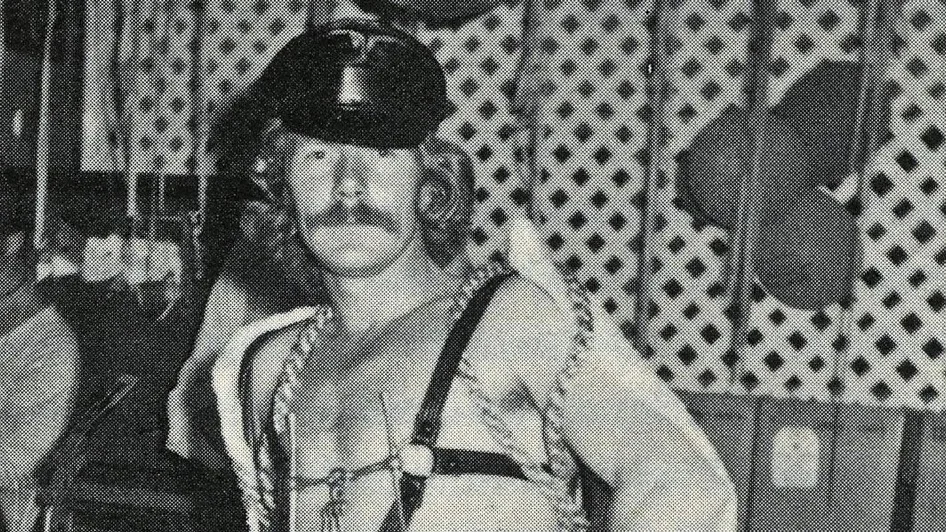Michael Fesco at the Ice Palace in Cherry Grove, 1970
A legend…
We’re saddened to hear that our community lost a legend this past weekend. Michael Fesco was behind the first Black and White Parties, Flamingo, the Ice Palace in Cherry Grove, Sea Tea and many other nightlife ventures. He and his work redefined the way we experience LGBTQ nightlife today.
Ice Palace Poster
The Ice Palace
Fesco’s career in nightlife began when he started working at what would later become the Ice Palace in Cherry Grove. The Fire Island Historical Preservation Society remembers:
In the summer of 1969 Michael Fesco a Broadway chorus boy between gigs found himself managing what was being referred to as the Boom Boom room in Cherry Grove. He turned up for the interview in a black mohair suit and tie., and within a month found himself running the whole complex. This included the hotel itself, the Sea Shack restaurant, and hotel bar. He immediately saw the potential in what he thought was the ugliest club he had ever seen. The club could fit 1,000 people easy, and so he set out to create Fire Islands first Disco at a time when gay liberation was exploding on the streets of Manhattan. After going to a club called “Sanctuary”, and experiencing the merging trend of a DJ and the crowds dynamic conversation that was beginning to happen he felt he had to bring that to Fire Island.
After reading a story by F. Scott Fitzgerald called ” The Ice Palace” he thought the name was perfect for the then Boom Boom room, which during season could get very hot.
A tea dance
THE TEA DANCE
Fesco is credited as having created the tea dance, to drive more business at the Ice Palace on slower Sundays. The article “The Tea Dance Is Part of NYC's LGBTQ Living History” explains:
The necessity of creating an alternative safe community space—and paying the rent—was the spark that first created the gay tea dance. In the late 60s, LGBTQ people were flocking to Fire Island/Cherry Grove where Michael Fesco ran a bar called The Ice Palace. Wondering how he was going to drum up more business on usually slow Sunday afternoons, Fesco remembered having high tea at 4 PM in England, where the bars would begin serving tea and crumpets. Cribbing from this and historically recognized tea dances, a tradition that was briefly revived in America from the late 1880s into the pre-WWII era, Fesco hosted the first tea dance in Cherry Grove where local drag queens served tea from a big silver pot and trays with delicate cups and saucers. Within a year, tea dances started popping up across the country. (Now, however, Lady Bunny says crumpets are a thing of the past, and the food stays in the realm of peanuts and popcorn and the occasional birthday cake—though she does add, “There’s always celery in Bloody Marys—I giggle that adding a vegetable to daytime drinking somehow adds a touch of health!”)
Membership cards to The Flamingo
The Flamingo
The Flamingo was New York’s first exclusively gay disco, and was opened by Michael Fesco on December 14, 1974. It was located on the second floor of a building at the corner of Houston and Broadway. Since there was a constant fear of police raids, the club had an unlisted telephone number, but members and those in the loops knew they would find it under “Gallery for the Promotion of People, Places, and Events” housed at 599 Broadway.
Members paid up to six hundred dollars a year for a membership to the club, which in those years was a lot of money. The Flamingo was in an upstairs loft space, and there were two women who operated the door, both with gardenias behind their ears. After passing them at the entrance they were the last women who you would see as in the beginning it was an “all male” club. The book Night Fever: Designing Club Culture articulates that Fesco offset the “industrial minimalism of the interior with spectacular floral arrangements.”
The club became famous for its intense and inventive parties, which foreshadowed the large gay circuit events of today. “They were the birthplace of the Black parties and White parties,” says writer Stuart Lee, adding that there were also set pieces such as a Crucifixion with the models dressed as Roman legionaries, and a Jesus Christ who would, from time to time, turn his eyes heavenward and ascend a cross.
In the book The Last Party: Studio 54, Disco, and the Culture of the Night, author Anthony Haden-Guest quotes Fesco as saying: “For the seven years that I was at Broadway and Houston we never had any problem with the neighbors. Everybody was gay, queer. Who cared? Now it seems like everyone cares. AIDS came along and the whole gay issue became a kind of phenomenon. And we got into a lot of trouble with the religious right and rednecks across the country.”
The Flamingo closed it’s doors in the winter of 1981, due to the popularity of The Saint that had just opened a few months prior.
Fesco was interviewed for the video series Stories of the Saint, where he explained: “But they kept talking about and talking about it but in my head, I just felt it [The Saint] would really never bother us at the Flamingo…. until it opened. Until I looked at it, then I said, ‘Holy Christ, we're in trouble.’”
Michael Fesco aboard one of his Sea Tea cruises
SEA TEA
Later, Fesco created Sea Tea, weekly tea dances with various themes that took place on a cruise ship that circled Manhattan.
Thank you Michael for everything you created. You will be missed but not forgotten.






